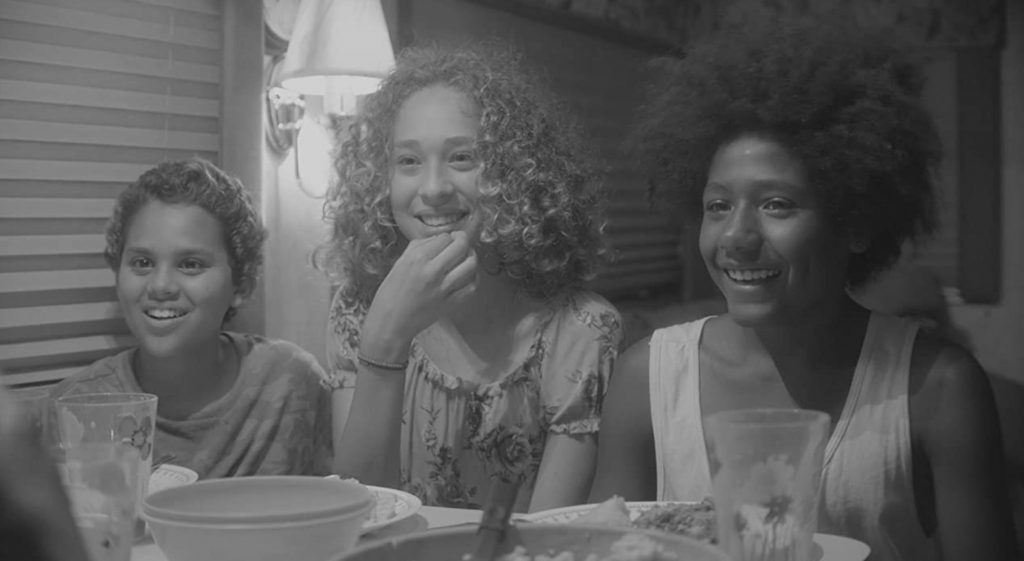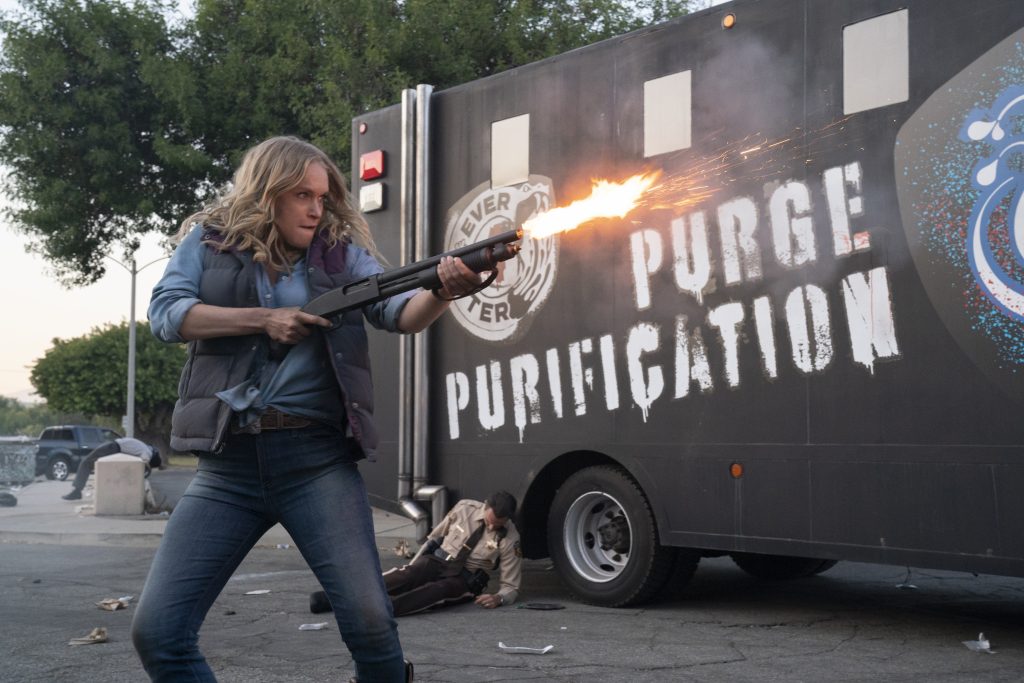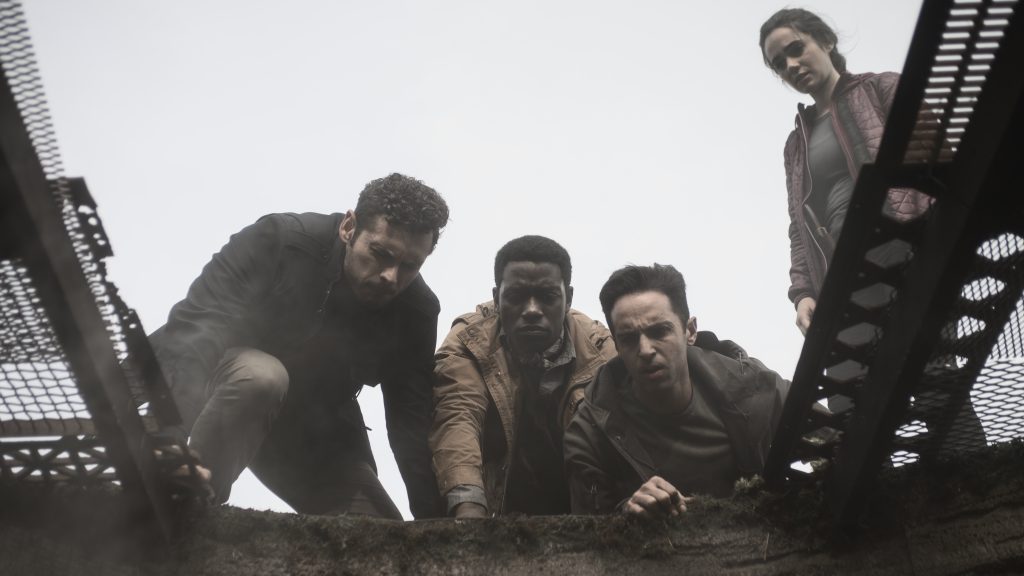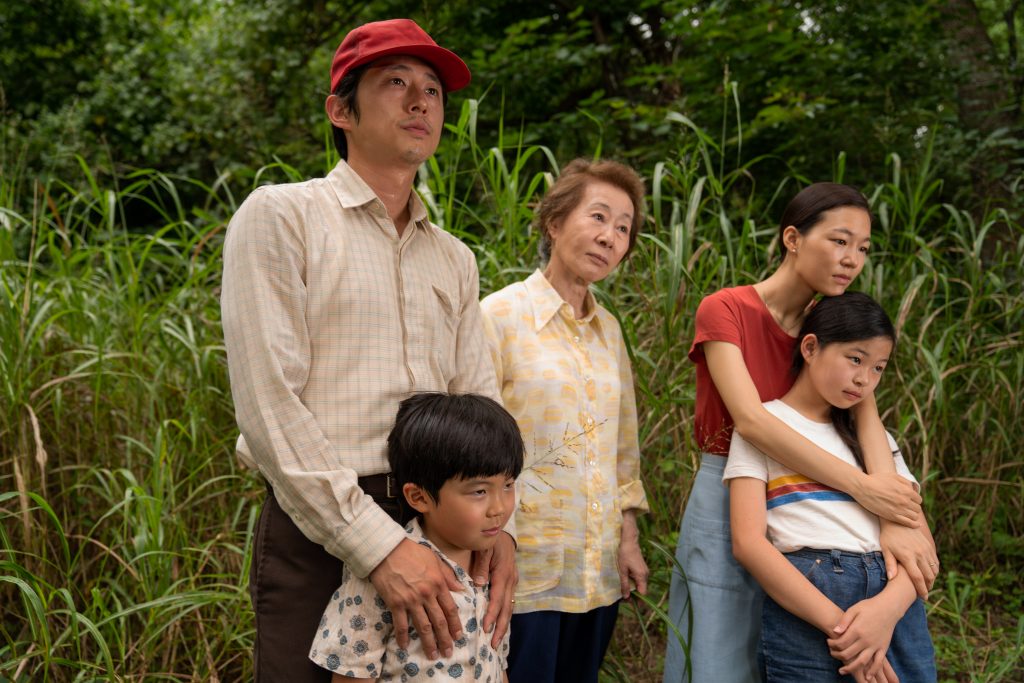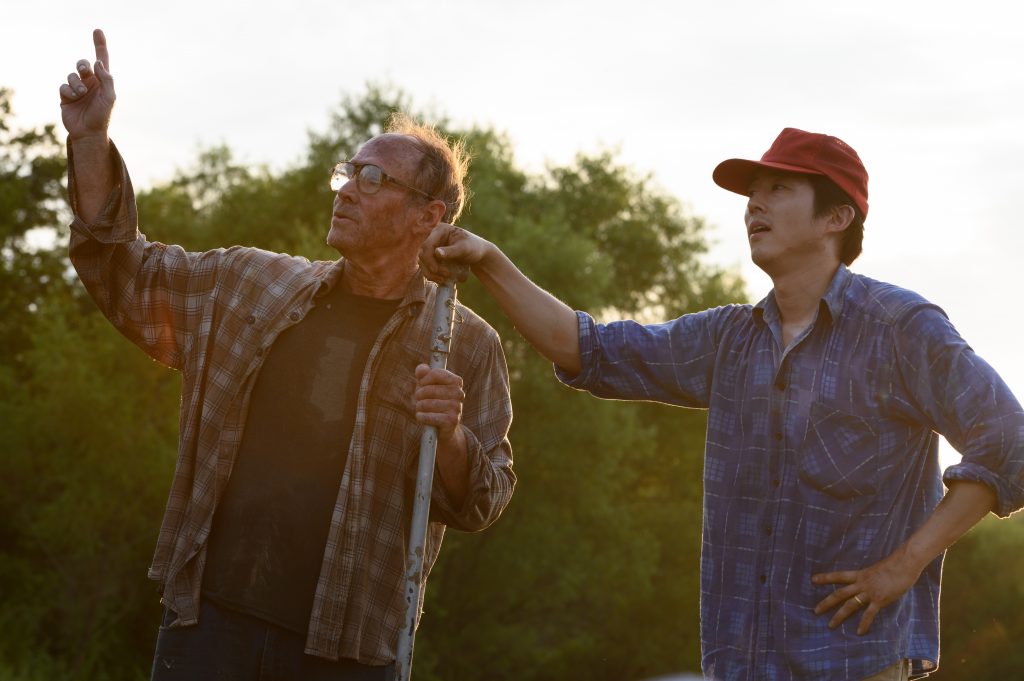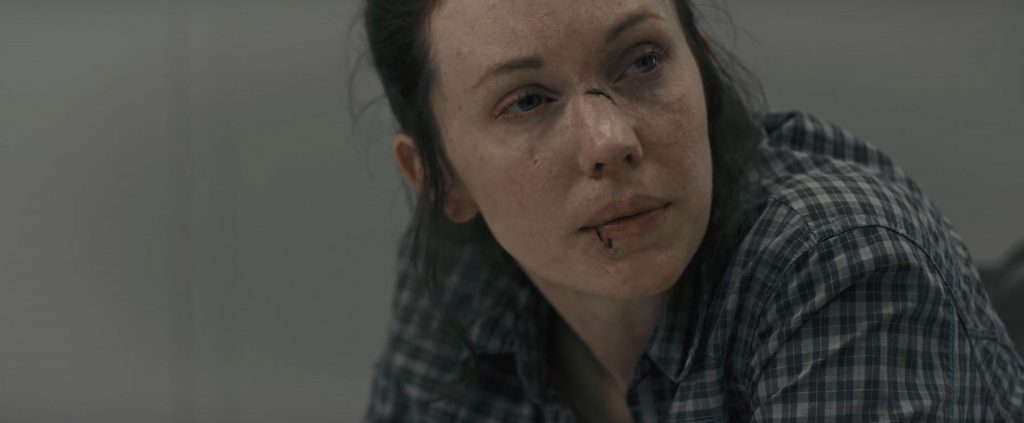October 16, 2021
by Carla Hay
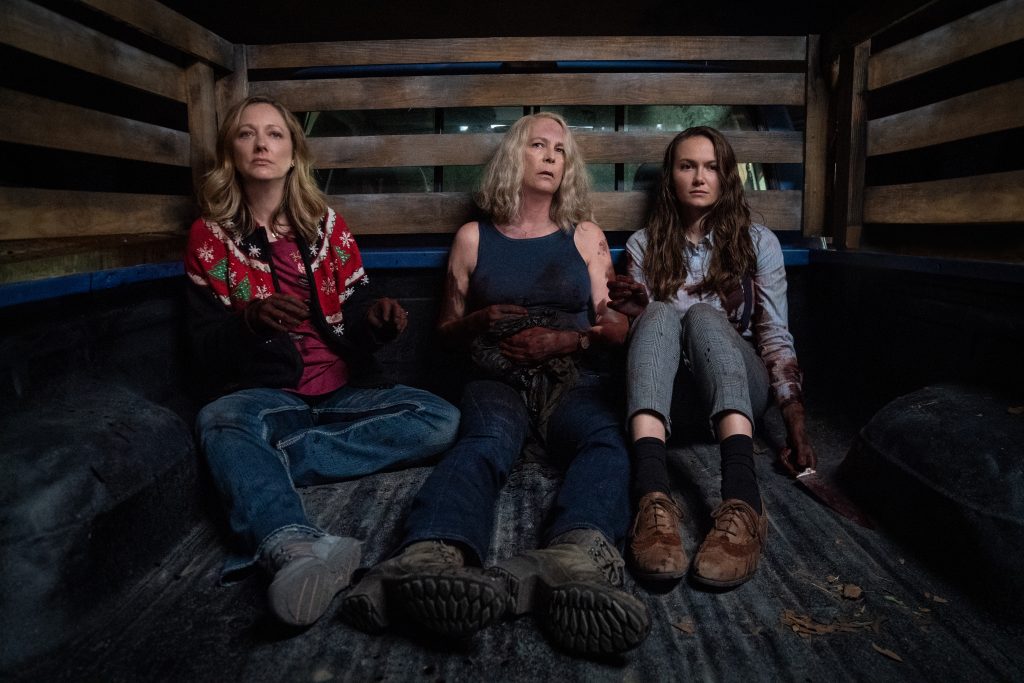
Directed by David Gordon Green
Culture Representation: Taking place in 2018, in the fictional Haddonfield, Illinois, the horror flick “Halloween Kills” has a predominantly white cast of characters (with a few African Americans) representing the working-class and middle-class.
Culture Clash: Serial killer Michael Myers is on the loose again and will murder anyone who gets in his way.
Culture Audience: “Halloween Kills” will appeal primarily to people who are interested in watching horror movies that care more about creating bloody murder scenes than creating any suspense or an interesting story.

“Halloween Kills” is an apt description for what this boring slog of a horror movie does to further destroy the already damaged “Halloween” franchise. It also commits the unforgivable sin of confining “Halloween” icon Laurie Strode to a hospital for most of the movie. Horror movie aficionados will find nothing scary about this cynical cesspool of lazy filmmaking, because “Halloween Kills” is just a series of gory murders thrown into an incoherent and flimsy plot.
The 2018 “Halloween” movie indicated that Jamie Lee Curtis’ Laurie Strode character (the most famous survivor of mask-wearing serial killer Michael Myers) would return to the franchise as an active hero doing battle against Michael Myers, who is also known as The Shape. The movie also introduced Laurie’s estranged daughter Karen (played by Judy Greer) and Karen’s daughter Allyson (played by Andi Matichak) into the mix, to make this hunt for Michael Myers a multi-generational family mission. At the end of the movie, Laurie and Karen had begun to mend their relationship, with Allyson being somewhat of a bridge between the two.
In “Halloween Kills,” which picks up right after the 2018 “Halloween” movie ended, any expectation that Laurie, Karen and Allyson would join forces is shattered. The three women spend most of the movie apart from each other. And when they are together, they often bicker with each other about who should or shouldn’t go after Michael Myers, who has returned to his hometown of Haddonfield, Illinois, to wreak more havoc on Halloween night. (“Halloween Kills” was actually filmed in North Carolina.) Meanwhile, men dominate in the planning of vigilante mob actions that play out in “Halloween Kills” in the most ludicrous ways.
David Gordon Green directed 2018’s “Halloween” and “Halloween Kills,” and he co-wrote both movies with Danny McBride. Jeff Fradley was the third co-writer of 2018’s “Halloween,” while Scott Teems was the third co-writer of “Halloween Kills.” It’s difficult to know if replacing Fradley with Teems is the reason why the quality of the “Halloween Kills” screenplay took a noticeable descent into moronic hell. The 2018 “Halloween” movie is by no means a classic horror flick, but it’s an exceedingly better film than the dreck of “Halloween Kills.” The director is chiefly responsible for how a movie turns out, so it’s disappointing that Green chose to coast off of the success of his “Halloween” movie and churn out such a formulaic and unimaginative dud with “Halloween Kills.”
Simply put: “Halloween Kills” wallows in the worst stereotypes of awful horror flicks. Characters go into a house alone to try and confront the extremely dangerous killer on the loose. When opportunities come to capture or kill the murderer once and for all, characters stand around talking to (or screaming at) the mute psycho killer Michael Myers, as if they think striking up a one-way conversation with him will suddenly turn him to a reasonable, law-abiding citizen. (In “Halloween Kills,” Michael Myers is portrayed by three actors: James Jude Courtney and Nick Castle in the 2018 scenes and Airon Armstrong in the 1978 scenes.)
And even though this serial killer is murdering people all over town, police officers and ambulances are mysteriously absent for most of the mayhem because almost all the imbecile characters in this movie usually don’t call 911. The nonsensical explanation in the movie is that the vigilante citizens think they can take Michael Myers on their own. Many of them think the Haddonfield police are incompetent. But that still doesn’t explain why the police aren’t showing up in force anyway.
And worst of all for a horror movie: There’s almost no suspense and nothing is truly terrifying. Gruesome? Yes. Scary? No. It’s very easy to predict who will die and who will survive in this movie. There’s also the predictable ending scene of someone who might or might not be dead. (It’s the most obvious way for a horror movie to set up a sequel.) The murders are done in such a monotonously routine way, it would be understandable for viewers to think that Michael Myers is sleepwalking. There is absolutely nothing creatively done in this movie when it comes to the plot, dialogue or action sequences.
“Halloween Kills” also squanders a compelling idea of reuniting many of the characters who survived the Michael Myers massacre that took place in the original 1978 “Halloween” movie. Several characters are introduced as having a meaningful connection to “Halloween” lore, but “Halloween Kills” won’t let viewers get to know these characters in a meaningful way. There are flashbacks in “Halloween Kills” that are ultimately a waste of time.
In one such flashback, which takes place in 1978 during Michael Myers’ first massacre in Haddonfield, viewers see a rookie cop in his 20s named Hawkins (played by Thomas Mann) and his older, more experienced partner Pete McCabe (played by Jim Cummings) on the scene. They are among the first cops to respond to this emergency. It’s enough to say that McCabe doesn’t make it out alive, but Hawkins does. In 2018, Hawkins (played by Will Patton) is still a Haddonfield cop, and he’s been wounded in this latest Michael Myers massacre.
Laurie is also wounded, because Michael stabbed her in the abdomen, as shown in 2018’s “Halloween.” She’s first seen in “Halloween Kills” bleeding profusely and in agony in the back of a truck with Karen and Allyson, as the truck speeds to the nearest hospital. It’s at this hospital that Laurie will stay for most of her screen time in “Halloween Kills.” She’s sidelined into being either being unconscious or, when she wakes up, being a cranky grandmother who thinks she knows best when it comes to who should go after Michael Myers.
And what a coincidence: A wounded Hawkins ends up being in the same hospital room as Laurie. There’s an almost laughable backstory put in “Halloween Kills” that Laurie and Hawkins had a flirtation with each other back in 1978. And so, in the midst of all the madness and mayhem with this latest Michael Myers killing spree, Laurie and Hawkins make goo-goo eyes at each other in their hospital beds, as they reminisce about their “could’ve been” near-miss romance. It’s an example of how off-the-rails this movie is in keeping Laurie mostly out of the action.
Besides Laurie and Hawkins, these are the other Haddonfield survivors from the original 1978 massacre who become targets of Michael Myers in the 2018 massacre:
- Tommy Doyle (played by Anthony Michael Hall): In 1978, Laurie was babysitting Tommy and his sister on the Halloween night when Michael Myers went on his deadly rampage. Tommy’s sister became one of Michael Myers’ murder victims.
- Lindsey Wallace (played by Kyle Richards): She was also a kid in 1978, and her babysitter was murdered by Michael Myers that night.
- Marion Chambers (played by Nancy Stephens): She was the nurse of the late Dr. Loomis (played by Donald Pleasance), the psychiatrist who was treating Michael Myers when Michael escaped from the psychiatric institution on that fateful Halloween in 1978. (Stephens reprises her role that she had in 1978’s “Halloween” movie.)
- Lonnie Elam (played by Robert Longstreet): When he was 9 or 10 years old, he had a near-miss encounter with Michael Myers on a sidewalk on Halloween night 1978. (Tristian Eggerling portrays Lonnie as a child in a flashback scene.)
“Halloween Kills” also has some other characters who encounter Michael Myers on Halloween night in 2018. Lonnie’s son Cameron Elam (played by Dylan Arnold) happens to be Allyson’s boyfriend. Cameron is also the person who finds a wounded Hawkins on the street. It’s one of the few times that someone in this movie has the common sense to call 911 for help. But that’s not what happens later in the movie when Lonnie, Cameron and Allyson foolishly decide to hunt down Michael Myers on their own.
Married couple Marcus (played by Michael Smallwood) and Vanessa (played by Carmela McNeal), who are dressed in Halloween costumes as a doctor and a nurse, meet Tommy at a local bar and quickly befriend him after he gets up on stage and talks about being a Michael Myers survivor. And there’s a gay couple named Big John (played by Scott MacArthur) and Little John (played by Michael McDonald), who work together in real estate. Big John and Little John happen to live in the house that Michael Myers used to live in before Michael was sent to a psychiatric institution in 1963 for killing his 17-year-old sister Judith when he was 6 years old. What are the odds that Michael will go back to his childhood home when Big John and Little John are there?
Michael Myers was supposed to be in his 20s in 1978, which means that he’s getting too old to have the type of superhuman strength that he has in these “Halloween” movies. He’s also been “killed” in several ways in various “Halloween” movies, but he still keeps coming back. All of that is explained in “Halloween Kills” when Laurie gives an absurdly bad monologue about how she’s come to the conclusion that Michael Myers is not human and he feeds off of people’s fear of him.
The “mob justice” aspect of “Halloween Kills” is idiotic and badly mishandled. Expect to see Tommy shout, “Evil dies tonight!” multiple times, as it becomes a rallying cry for the vigilante crowd. Just by coincidence, two psychiatric patients have escaped that night from a psychiatric institution that held Michael Myers. It’s a plot contrivance that’s set up for a silly “mistaken identity” subplot.
Even though the people of Haddonfield should know by now what Michael Myers’ height and general physical build should be (his body type hasn’t changed since 1978), the crazed vigilantes go after one of these escapees who’s considerably shorter and stockier than Michael Myers. Apparently, for this mob, any old psychiatric hospital escapee will do.
Karen is the only one with an iota of common sense to notice that this escapee doesn’t have Michael Myers’ physical characteristics. As the practical-minded Karen, Greer gives the best performance of this movie’s cast members. However, that’s not saying much because everyone’s acting in “Halloween Kills” is mediocre overall.
Oddly, there’s a lone elderly cop in uniform who gets swept up in the vigilante mob. His allegiances are never really clear. One minute, he seems to want to try to stop the mob madness. The next minute, he seems to be going along with the crowd. He doesn’t ask for backup from his fellow police officers. The only thing that’s clear is that he’s a terrible cop who should be fired and can kiss that pension goodbye.
There are many plot holes in “Halloween” that the filmmakers want to cover up with some cringeworthy dialogue and bloody action sequences. “Halloween Kills” has so much arguing and melodrama in a hospital, viewers will be wondering: “Is this a horror movie or a soap opera?” At one point, Laurie rips out her medical tubes and injects herself in the rear end with a painkiller. If you waited your whole life to see Laurie Strode give herself a butt injection, then “Halloween Kills” is the movie for you.
During one of her hospital rants, Laurie says to Karen about why Michael Myers is still on the loose and what Laurie wants to do about it: “The system failed … Let him come for me! Let him take my head as I take his! … You and Allyson shouldn’t have to keep running because of the darkness I created.”
But wait a minute, Laurie. “Halloween Kills” doesn’t want you to take all the credit for Michael Myers going on a rampage. Hawkins thinks Michael Myers is on this killing spree because of Hawkins. He makes a guilt-ridden confession that doesn’t make any sense at all for why Hawkins would be the reason for Michael Myers’ serial killings. There’s a badly written flashback scene involving a cover-up that wouldn’t be plausible in the real world because of autopsy reports and how bullet trajectories would be investigated.
It’s not as if viewers should expect a terrible horror movie like “Halloween Kills” to be realistic. But the movie just doesn’t offer a horrifying mystery, engaging new characters, or even twist-filled “hunt for the killer” chase scenes. It’s all so predictable, hollow and generic. “Halloween Kills” puts too much emphasis on a mindless and forgettable mob of people while sidelining Laurie Strode, the most memorable and iconic hero of the “Halloween” franchise. That’s the real injustice in “Halloween Kills.”
Universal Pictures released “Halloween Kills” in U.S. cinemas and on Peacock on October 15, 2021.

